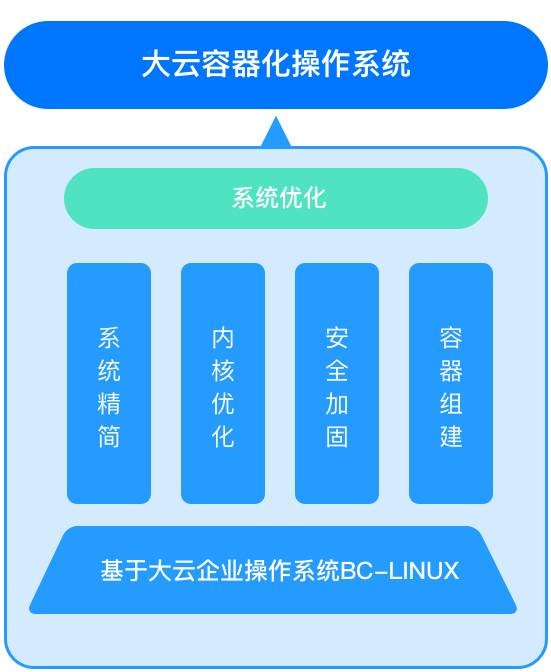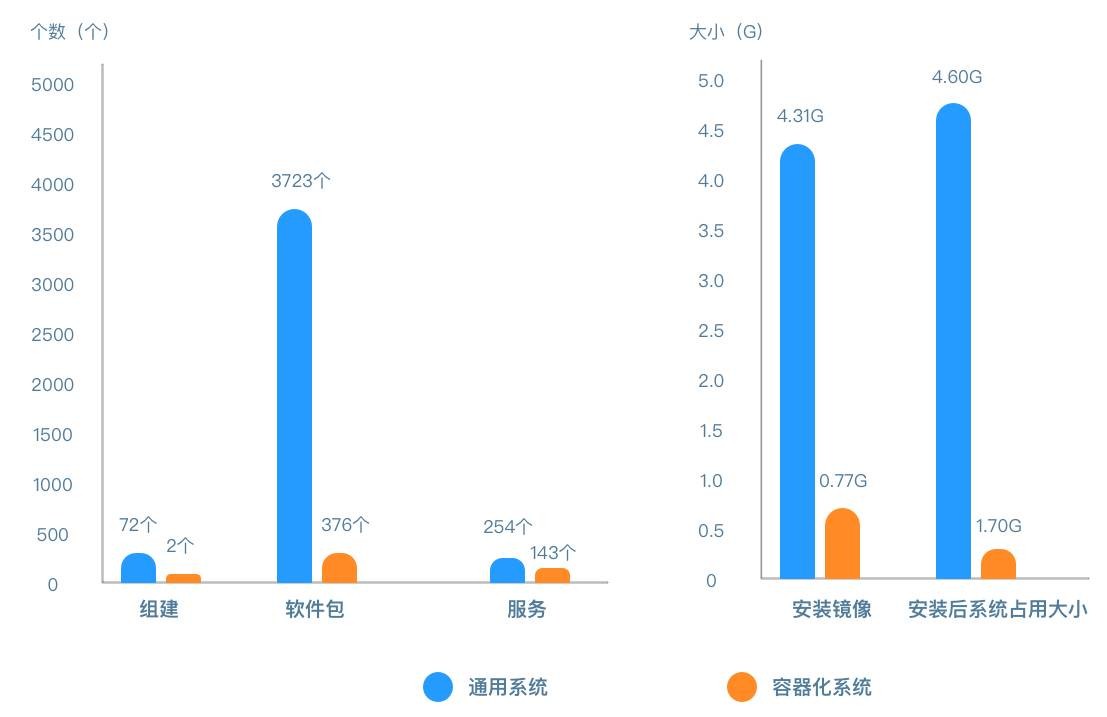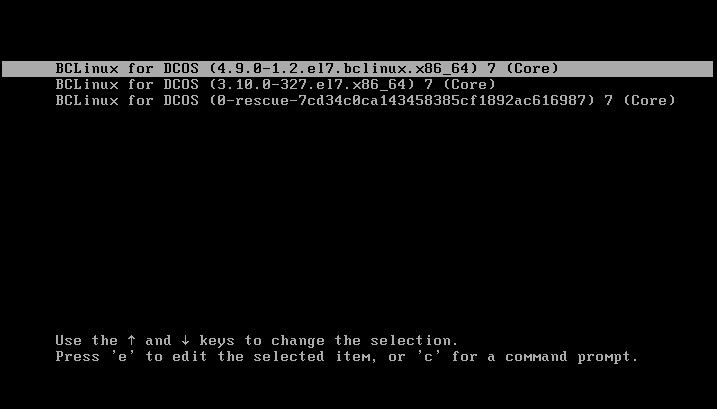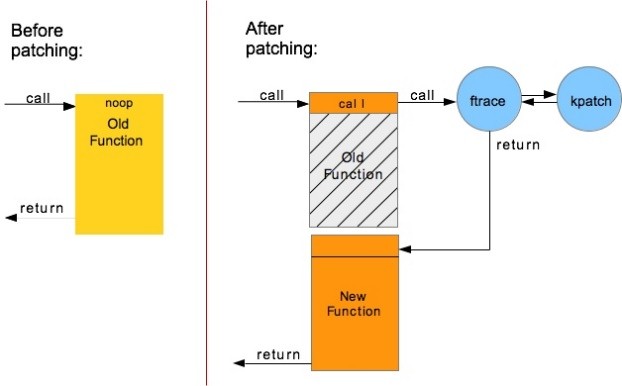Analysis of China Mobile's container-customized Linux operating system
General operating systems integrate a large number of software and enable many services by default. Most of these software and services are not required for the container environment. Therefore, deploying container services based on a general operating system will not only increase system overhead, but also lead to environmental instability and an expansion of the security attack surface. Compared with traditional general-purpose operating systems, container operating systems are deeply tailored and optimized for container applications, providing a lightweight minimum running environment for containers. This article introduces some of China Mobile’s attempts at containerized systems and some of its achievements.
China Mobile launched the research and development of a container-customized operating system in 2017, deeply customized it based on the Big Cloud operating system BC-LINUX, and officially released version 1.0 in May of that year, named "Big Cloud Containerized Operating System". BC-LINUX is an enterprise-level general-purpose Linux operating system independently developed by China Mobile based on the CentOS open source community and leveraging the openness advantages of open source technology through customized means. Currently, nearly 20,000 units have been deployed within China Mobile. On the basis of the general system, the Dayun containerized operating system provides a streamlined container operating environment through kernel optimization and system tailoring and other technical means, improves the system's operating speed, achieves system minimization and performance optimization. as the picture shows.

To strike a balance between system ease of use and simplicity, Dayun containerized operating system cuts out irrelevant software packages and services while retaining the basic functions of the system. On the basis of providing the minimum operating environment for containers, Dayun containerized operating system ensures that common services and functions of the operating system are not missing, reduces system overhead, and reduces the difficulty of system operation and maintenance. Compared with general systems, Dayun containerized operating system The number of system software packages has been reduced from 3723 to 376, the number of services has been reduced from 254 to 143, and the installation image size has been reduced from 4.31G to 770M, as shown in the figure.

Dayun containerized operating system integrates Docker components and provides 11 mainstream open source middleware container images for out-of-the-box use. We provide version updates, security warnings, vulnerability fixes and technical support services for these 11 open source components, and regularly scan and update to fix security vulnerabilities in container images to ensure that there are no security issues in container images, as shown in the figure.

For container usage scenarios, Dayun containerized operating system provides an optimized customized kernel. The customized kernel is customized and developed based on the latest long-term support version 4.9 of the kernel community. The kernel is tailored for the container business and adds many function enhancements and performance optimizations for XFS, Btrfs and Overlayfs. The Dayun container operating system supports the overlay2 storage driver. Compared with overlay, the overlay2 of Dayun containerized operating system is more efficient in terms of inode usage. In addition, China Mobile's multiple patches for containers are added to the customized kernel, which realizes the separation of some network configuration parameters of the container and the host system, and meets the tuning needs of the container business system in high network concurrency scenarios, as shown in the figure.

The big cloud containerized system reduces the security attack surface of the system by cutting out unnecessary services. At the same time, the system has built-in security hardening software independently developed by China Mobile, which can comprehensively scan the system for security vulnerabilities and security configuration issues, provide security assessment results and repair suggestions, and can harden the system with one click and turn on the system security mode.
The customized kernel is based on the 4.9 kernel, and higher versions of the kernel have fixed many security vulnerabilities, such as the kernel privilege escalation vulnerability Dirty Cow (CVE-2016-5195). A system with this vulnerability can bypass the system's security policy in the container and obtain root permissions of the host system, and then can view, modify or even delete any files in the host, thus posing security risks to the host and other containers.
In response to the problem of business interruption caused by dynamic library and kernel upgrades in traditional upgrade methods, Dayun containerized operating system has launched hot patch technology. Hot patch technology is an online defect and vulnerability repair technology that does not affect the business. It can achieve online upgrades of dynamic libraries and kernels without interrupting services or restarting the system. It does not affect system performance and significantly improves business performance. System stability and availability.
Specifically, dynamic library hot upgrade solves the problem of dynamic library upgrade of business programs. It is suitable for dynamic library upgrade of all processes. It is simple and convenient to operate, has high reliability, and supports multiple re-entry and reverse operations, as shown in the figure. .

Kernel hot upgrade technology, based on the kernel's ftrace mechanism, dynamically adds detection points to realize online replacement of function-level execution processes. This technology allows kernel upgrades without restarting the system, minimizing system downtime. For important security vulnerabilities, Dayun containerized operating system can respond quickly. At the same time, the system supports rollback operations and can quickly restore the kernel to the state before the upgrade.
For containerized operating systems, Dayun can provide continuous system updates and technical support services, track security vulnerabilities in the operating system, especially Docker components, and issue security warnings and vulnerability update patch packages, as shown in the figure.

Since its release, the Dayun containerized operating system has been commercially promoted within China Mobile. The current deployment scale has reached nearly 200 nodes. It uses the Kubernetes container management platform and has been running stably for 6 months, supporting 5,000 containers. The product’s Safety, stability and reliability have been fully verified in the project.
The above is the detailed content of Analysis of China Mobile's container-customized Linux operating system. For more information, please follow other related articles on the PHP Chinese website!

Hot AI Tools

Undresser.AI Undress
AI-powered app for creating realistic nude photos

AI Clothes Remover
Online AI tool for removing clothes from photos.

Undress AI Tool
Undress images for free

Clothoff.io
AI clothes remover

Video Face Swap
Swap faces in any video effortlessly with our completely free AI face swap tool!

Hot Article

Hot Tools

Notepad++7.3.1
Easy-to-use and free code editor

SublimeText3 Chinese version
Chinese version, very easy to use

Zend Studio 13.0.1
Powerful PHP integrated development environment

Dreamweaver CS6
Visual web development tools

SublimeText3 Mac version
God-level code editing software (SublimeText3)

Hot Topics
 What computer configuration is required for vscode
Apr 15, 2025 pm 09:48 PM
What computer configuration is required for vscode
Apr 15, 2025 pm 09:48 PM
VS Code system requirements: Operating system: Windows 10 and above, macOS 10.12 and above, Linux distribution processor: minimum 1.6 GHz, recommended 2.0 GHz and above memory: minimum 512 MB, recommended 4 GB and above storage space: minimum 250 MB, recommended 1 GB and above other requirements: stable network connection, Xorg/Wayland (Linux)
 vscode cannot install extension
Apr 15, 2025 pm 07:18 PM
vscode cannot install extension
Apr 15, 2025 pm 07:18 PM
The reasons for the installation of VS Code extensions may be: network instability, insufficient permissions, system compatibility issues, VS Code version is too old, antivirus software or firewall interference. By checking network connections, permissions, log files, updating VS Code, disabling security software, and restarting VS Code or computers, you can gradually troubleshoot and resolve issues.
 How to run java code in notepad
Apr 16, 2025 pm 07:39 PM
How to run java code in notepad
Apr 16, 2025 pm 07:39 PM
Although Notepad cannot run Java code directly, it can be achieved by using other tools: using the command line compiler (javac) to generate a bytecode file (filename.class). Use the Java interpreter (java) to interpret bytecode, execute the code, and output the result.
 What is vscode What is vscode for?
Apr 15, 2025 pm 06:45 PM
What is vscode What is vscode for?
Apr 15, 2025 pm 06:45 PM
VS Code is the full name Visual Studio Code, which is a free and open source cross-platform code editor and development environment developed by Microsoft. It supports a wide range of programming languages and provides syntax highlighting, code automatic completion, code snippets and smart prompts to improve development efficiency. Through a rich extension ecosystem, users can add extensions to specific needs and languages, such as debuggers, code formatting tools, and Git integrations. VS Code also includes an intuitive debugger that helps quickly find and resolve bugs in your code.
 Can vscode be used for mac
Apr 15, 2025 pm 07:36 PM
Can vscode be used for mac
Apr 15, 2025 pm 07:36 PM
VS Code is available on Mac. It has powerful extensions, Git integration, terminal and debugger, and also offers a wealth of setup options. However, for particularly large projects or highly professional development, VS Code may have performance or functional limitations.
 How to use VSCode
Apr 15, 2025 pm 11:21 PM
How to use VSCode
Apr 15, 2025 pm 11:21 PM
Visual Studio Code (VSCode) is a cross-platform, open source and free code editor developed by Microsoft. It is known for its lightweight, scalability and support for a wide range of programming languages. To install VSCode, please visit the official website to download and run the installer. When using VSCode, you can create new projects, edit code, debug code, navigate projects, expand VSCode, and manage settings. VSCode is available for Windows, macOS, and Linux, supports multiple programming languages and provides various extensions through Marketplace. Its advantages include lightweight, scalability, extensive language support, rich features and version
 What is the main purpose of Linux?
Apr 16, 2025 am 12:19 AM
What is the main purpose of Linux?
Apr 16, 2025 am 12:19 AM
The main uses of Linux include: 1. Server operating system, 2. Embedded system, 3. Desktop operating system, 4. Development and testing environment. Linux excels in these areas, providing stability, security and efficient development tools.
 How to check the warehouse address of git
Apr 17, 2025 pm 01:54 PM
How to check the warehouse address of git
Apr 17, 2025 pm 01:54 PM
To view the Git repository address, perform the following steps: 1. Open the command line and navigate to the repository directory; 2. Run the "git remote -v" command; 3. View the repository name in the output and its corresponding address.






